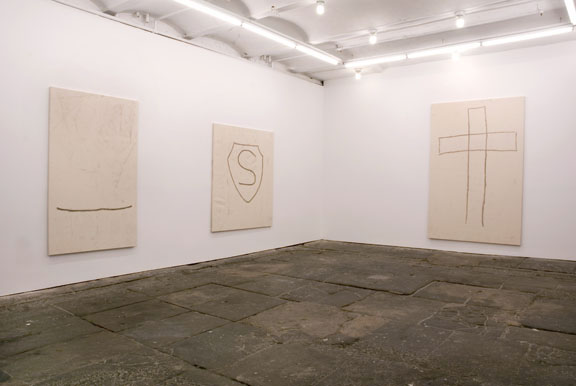This is an archive of the ArtCat Zine, 2007-2009. Please visit our new project, IDIOM.
Joe Bradley at CANADA

Schmagoo Paintings
Joe Bradley
CANADA - 55 Chrystie St, New York NY
25 October - 3 December 2008
For Joe Bradley's charming second show at CANADA, the modern world is encapsulated in the images of Superman's "S", the number "23" (possibly recalling Michael Jordan's uniform), a cross and other symbols -- some whole, some broken. The pictures emerge prehistoric, as black grease pencil doodles on unprimed canvases. The first work one encounters upon entering the gallery is a large canvas titled Schmutz Painting, devoid of any marking except a dusting of schmutz -- the Yiddish word for dirt. The title is a play on the exhibition title itself, Schmagoo, which Bradley thought sounded like the name of a Jewish superhero. Not coincidentally, there is schmutz on the five other works in the exhibition as well.
Through inscription, monument and other forms of material remembrance, past symbols and names outlive their time. Look closely, though, and the memories preserved transmogrify. They seem both familiar and obscure. The philosopher Walter Benjamin was riveted by this tension. For him, images and objects possessed an immanent power, and he considered how such power translated over time. He believed this history is collapsed into images, and it was the historian's job to rescue those which would resonate now. Writing from a Marxist perspective, he thought that by recovering and showing them again, the images could take on a kind of revolutionary potential. That potential comes from the viewer's critical distance and recognition. The moment we see a past image in a new form, like a painting, our past perception of the image merges with, and is transformed by, the present. Myths combine with contemporeneous specificities. New possibilities open up for exploring and changing the current tides of culture. Benjamin calls this the shock of the dialectical image. Bradley's painting may not exactly ignite new ways of thinking, but a weird scrawl of Michael Jordan's number is at least amusing. As Bradley explains in the press release, schmagoo is also old slang for heroin, which he uses as "a metaphor for the original creative act. The Word made Flesh. The transmutation of Schmagoo into Alchemical Gold." His vernacular -- childhood heroes, sports icons and associations -- has achieved a redemptive state. The pictures become our contemporary talismans.
Prior to this exhibition, Bradley's best known pieces were wall-mounted figures made up of monochrome canvases, resembling a convocation of Tetris shapes. They challenged the notion that as a minimal installation, these rectangular assortments ought to be read as abstract, both art historically and colloquially. His new work again considers minimalism, but also offers a perverted take on an imagined primitivism. As a whole, the exhibition falls somewhere on the continuum between lightly conceptual and prank. If an archaeologist scrutinized Bradley's work as seriously as he would a cave painting, he would most likely consider our society consumer-driven, shallow and a little silly. Bradley might shrug and laugh at him. The self-effacing tone of the exhibit is, in the end, more exciting than the work itself, though the banality of the paintings grew on me with a second gallery visit. Upon leaving, I felt lighter.
ZINE
HOME
TIPS / COMMENTS
CATEGORIES
CONTRIBUTORS
- Greg Afinogenov
- B. Blagojevic
- Adda Birnir
- Susannah Edelbaum
- Julie Fishkin
- Paddy Johnson
- Jessica Loudis
- Christopher Reiger
- Andrew Robinson
- Peter J. Russo
- Blythe Sheldon
- S.C.Squibb
- Hrag Vartanian
